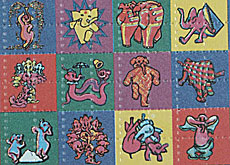LSD turns 60

Lysergic acid diethylamide (LSD), the hallucinogenic drug that defined the Sixties, is celebrating its 60th birthday.
Discovered by the Swiss scientist Albert Hofmann, the drug not only fuelled the hippie age but was also a well-respected treatment for a variety of psychiatric disorders.
For many years it was used to treat alcoholism, obsessive-compulsive disorders and used on patients who had difficulty expressing their emotions.
But it seems that LSD has passed its sell-by date, as the drug is no longer desirable (or legal) for treating such disorders.
Even in the recreational drug scene, LSD is to a large extent a thing of the past with newer drugs such as ecstasy more in vogue with today’s youth than with the baby boomers of days past.
Out of vogue
Hofmann discovered the drug while he was working for the Basel-based pharmaceutical company, Sandoz (which later merged with Ciba-Geigy to become Novartis).
From 1947 to 1966, Sandoz produced and sold LSD tablets and the drug became popular, especially in the United States.
In fact, the 1960s might not have been quite as free loving had the patent for LSD not run out in 1963, which meant the formula for the drug was no longer a secret.
For some, the hallucinogenic effects of LSD were a ticket to the spiritual world, for others it opened doors to their creativity that they never dreamed possible.
In the 1960s and 70s Hofmann received dedications from some of the century’s leading artists, among them “pop” artist Andy Warhol and the author Aldous Huxley, who said their work was influenced by LSD.
Accidental discovery
During the Second World War, Hofmann was researching circulatory stimulants when he remembered a chemical that had been cast away as ineffective five years earlier.
It was a derivate of a substance found in ergot, a fungus that grows on rye and other cereals. By 1943, Sandoz had developed improved testing methods, so Hofmann decided to take another look at the chemical.
“By chance, I got a whiff, and immediately felt exhilarated,” he recalled in an interview with swissinfo in 2001 when he turned 95.
His curiosity aroused, Hofmann decided to use himself as a guinea pig. On a spring day he took 0.25 milligrams of LSD – three times the amount needed for a fully-fledged high. “It was a horror trip,” he remembers.
He continued to experiment with the drug and found that the trips brought him visions as well as feelings of happiness.
Hofmann, who condemned the mass use of LSD, said he remains convinced of the drug’s therapeutic properties for the mind.
He is critical of a total ban on LSD. “For psychological purposes and for further research, LSD should be legalised,” he says.
The 97-year-old Hofmann is scheduled to attend a book fair in Basel in early May where he plans to read passages from some of the books that he has written on LSD.
swissinfo with agencies
LSD was discovered by the Swiss scientist, Albert Hofmann, while working for a pharmaceutical company.
It was sold in tablet form by Sandoz from 1947 to 1966.
LSD was widely used and respected for the treatment of psychological disorders.
The expiration of the drug’s patent in 1963 meant the formula for the drug was no longer secret and contributed to its widespread use.

In compliance with the JTI standards
More: SWI swissinfo.ch certified by the Journalism Trust Initiative

You can find an overview of ongoing debates with our journalists here . Please join us!
If you want to start a conversation about a topic raised in this article or want to report factual errors, email us at english@swissinfo.ch.